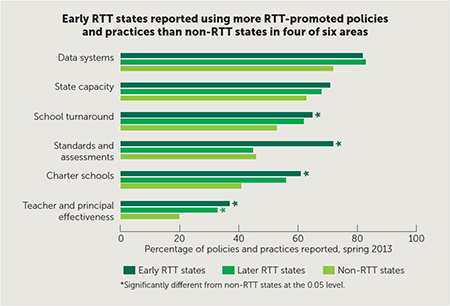
States that received Race to the Top (RTT) grants used more of the policies and practices the program promoted than states that did not receive grants, but RTT’s effect on student achievement was not clear, according to a new report released by the U.S. Department of Education. Through more than $4 billion dollars in grants to states, RTT aimed to improve student achievement, including that of high-need students like English language learners (ELLs). The final report from Mathematica Policy Research’s multiyear evaluation sheds light on the policies and practices states reported using in 2013 and examines the relationship between RTT and student achievement. Mathematica led and conducted the evaluation with its partners, American Institutes for Research (AIR) and Social Policy Research Associates (SPR), for the U.S. Department of Education’s Institute of Education Sciences.
“In sum, it is not clear whether the RTT grants improved student achievement,” says Lisa Dragoset, a senior researcher at Mathematica and director of the evaluation. “Differences in student achievement between RTT states and other states may be due to other factors and not to the program. For example, RTT states differed from other states before receiving the grants in a number of ways. Other changes that occurred at the same time as RTT reforms may also have affected student achievement.”
The evaluation found that:
- Early RTT states (that received Round 1 or Round 2 grants in 2010) reported using more RTT-promoted policies and practices than non-RTT states (that did not receive grants) in four of six areas: (1) turning around low-performing schools, (2) adopting standards and assessments that prepare students to succeed in college and the workplace, (3) encouraging conditions in which charter schools can succeed, and (4) improving teacher and principal effectiveness. There were no differences between the two groups in the other two areas—building state data systems that measure student growth and inform instruction, and improving state capacity to support school improvement efforts.
- Later RTT states (that received Round 3 grants in 2011) reported using more RTT-promoted policies and practices than non-RTT states in one of the six areas: improving teacher and principal effectiveness.
- Across all six areas, early RTT states reported using more ELL-focused policies and practices than non-RTT states. Later RTT states did not differ from non-RTT states in their use of ELL-focused policies and practices.
- The effect of RTT on student achievement was not clear. Different, reasonable interpretations of how student achievement was trending before RTT yield conflicting conclusions.
The analysis of implementation of RTT policies and practices was based on structured telephone interviews conducted in 2013 with representatives from state education agencies from 50 states and the District of Columbia. The descriptive analysis of the relationship between RTT and student achievement was based on publicly available, state-level test scores from the National Assessment of Educational Progress.
Read the fact sheet and explore the findings interactively.
About AIR: Established in 1946, with headquarters in Washington, DC, the American Institutes for Research is a nonpartisan, not-for-profit organization that conducts behavioral and social science research and delivers technical assistance both domestically and internationally in the areas of health, education, and workforce productivity. For more information, visit www.air.org.
About SPR: Social Policy Research Associates provides customized services in evaluation, organizational development, and facilitation and training. Located in Oakland, CA, SPR works collaboratively with clients to bring innovative approaches to new or existing strategies, programs, and initiatives. The staff consists of more than 30 professionals with backgrounds in diverse disciplines, including education, sociology, public policy, and economics. For more information, visit www.spra.com.
